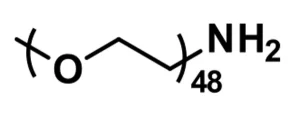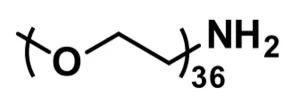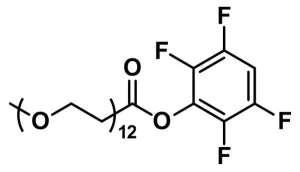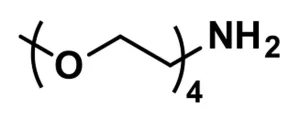m-dPEG®24-amine, product number QBD-10318, is a non-immunogenic, water-soluble chemical modification reagent. The product contains a single molecular weight, discrete-length polyethylene glycol (dPEG®) chain terminated on one end with a methyl group and on the other end with a reactive primary amine. The amino group reacts with carboxylic acids (and their active esters), aldehydes, and ketones. Reacting the amino group with aldehydes or ketones forms a labile imine (Schiff base). Reacting carboxylic acids or their active esters with m-dPEG®24-amine forms stable amide bonds. Uses for this product include passivating surfaces and coating biomolecules.
Biomolecules modified with m-dPEG®24-amine display enhanced water solubility, increased hydrodynamic volume, and reduced immunogenicity. This product reacts quickly with active esters of carboxylic acids (for example, NHS esters and TFP esters) to form amide bonds. Also, it forms amide bonds directly with carboxylic acids using the carbodiimide EDC.
Several publications in the scientific literature report the successful use of m-dPEG®24-amine. Published reports using this product include:
development of molecular pincers as protein sensors;
development and modification of luminescent Iridium (III) polypyridine complexes for use as biological labels and probes;
development of probes for continuous real-time modification of renal function; and,
development of a membrane filter system with antifouling properties for water purification.
| Unit Size | 100 mg, 1000 mg |
|---|---|
| Molecular Weight | 1088.32; single compound |
| Chemical formula | C₄₉H₁₀₁NO₂₄ |
| CAS | 32130-27-1 |
| Purity | > 97% |
| Spacers | dPEG® Spacer is 74 atoms and 86.1 Å |
| Shipping | Ambient |
| Typical solubility properties (for additional information contact Customer Support) | Methylene chloride, Acetonitrile, DMAC, DMSO or water. |
| Storage and handling | -20°C; Always let come to room temperature before opening; be careful to limit exposure to moisture and restore under an inert atmosphere; stock solutions can be prepared with dry solvent and kept for several days (freeze when not in use). dPEG® pegylation compounds are generally hygroscopic and should be treated as such. This will be less noticeable with liquids, but the solids will become tacky and difficult to manipulate, if care is not taken to minimize air exposure. |
Greg T. Hermanson, Bioconjugate Techniques, 3rd Edition, Elsevier, Waltham, MA 02451, 2013, ISBN 978-0-12-382239-0; See chapter 18, Discrete PEG Reagents, pp.787-821, for a full overview of the dPEG® products.
Molecular Pincers: Antibody-Based Homogeneous Protein Sensors. Ewa Heyduk, Benjamin Dummit, yie-Hwa Chang, and Tomasz Heyduk, Anal. Chem., 2008, 80 (13), pp 5152–5159 May 21, 2008. DOI: 10.1021/ac8004154.
Modification of Luminescent Iridium (III) Polypyridine Complexes with discrete Poly(ethylene glycol) (PEG) Pendants: Synthesis, Emissive behavior, Intracellular Uptake, and PEGylation Properties. Steve Po-Yam Li, Hua-Wei Liu, Kenneth Yin Zhang, and Kenneth Kam-Wing Lo. Chemistry A European Journal. 2010, 16 (28), pp. 8329 – 8339. July 26, 2010. DOI: 10.1002/chem.201000474.
New optical probes for the continuous monitoring of renal function. Richard B. Dorshow, Bethel Asmelash, Lori K. Chinen, Martin P. Debreczeny, Richard M. Fitch, John N. Freskos, Karen P. Galen, Kimberly R. Gaston, Timothy A. Marzan, Amruta R. Poreddy, Raghavan Rajagopalan, Jeng-Jong Shieh, William L. Neumann. Proc. SPIE 6867, Molecular Probes for Biomedical Applications II. 2008. 68670C. February 13,2008. DOI: 10.1117/12.763697.
Luminescent Iridium(III) Polypyridine PEG Complexes: Synthesis, Photophysical, and Biological Properties. Steve Po-Yam Li, Johnson Lui-Lui Tsai, and Kenneth Kam-Wing Lo. NANOMED. 2010, pp 66-71. December 5, 2010. http://dx.doi.org/10.1109/NANOMED.2010.5749807.
Design of cyclometalated iridium(III) polypyridine complexes as luminescent biological labels and probes. Kenneth Kam-Wing Lo, Kenneth Yin Zhang, and Steve Po-Yam Li. Pure Appl. Chem. 2011, 83, (4) pp 823–840. February 28, 2011. DOI: 10.1351/PAC-CON-10-08-20.
Antifouling and tunable amino functionalized porous membranes for filtration Applications. Bijay P. Tripathi, Nidhi C. Dubey, S. Choudhury and M. Stamm. Journal of Materials Chemistry. 2012, 22 (1) pp 19981-19992. August 1, 2012. DOI: 10.1039/c2jm34172g.
Cell-Specific Delivery of Diverse Cargos by BacteriophageMS2 Virus-like Particles. Carlee E. Ashley Eric C. Carnes, Genevieve K. Phillips, Paul N. Durfee, Mekensey D. Buley, Christopher A. Lino, David P. Padilla, Brandy Phillips, Mark B. Carter, Cheryl L. Willman, C. Jeffrey Brinker, Jerri do Carmo Caldeira, Bryce Chackerian, Walker Wharton, and David S. Peabody.ACS Nano, 2011, 5 (7), pp 5729–5745, May 26, 2011. DOI: 10.1021/nn201397z.
Applicable patents and legal notices are available at legal notices.




Stay in the Loop. Join Our Online Community
Products
Ordering
About Us
Application
Resources

©Vector Laboratories, Inc. 2025 All Rights Reserved.
To provide the best experiences, we use technologies like cookies to store and/or access device information. Consenting to these technologies will allow us to process data such as browsing behavior or unique IDs on this site. Not consenting or withdrawing consent, may adversely affect certain features and functions. Privacy Statement
How do I Request a Quote?
To request a quote for products: